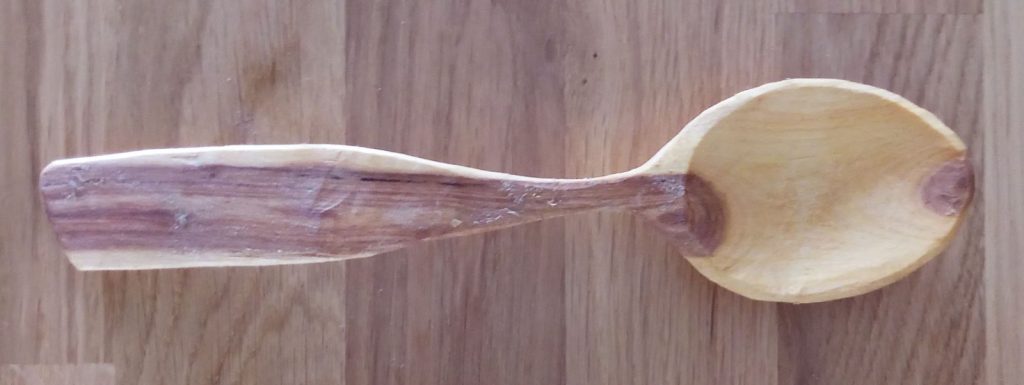Last winter we spent quite a lot of time and energy laying some hedge along the northern boundary of Hare’s Rise. I think we all enjoy the work – we don’t kill ourselves trying to get lots done, rather we pick away at it, doing a short stretch each year. But even that amount seems to produce a huge amount of brash and small diameter wood for which there seem few good uses. The thicker stuff we chop up for firewood and we get sufficient bean poles for the allotment, but that still leaves a lot that we just burn. So from all of that wood I picked a few bits out and had a go at making some spoons.

What’s great about carving spoons is you really don’t need much in the way of tools or timber. The first spoon I made I carved with my Opinel penknife but then went and bought a Scandinavian Sloyd knife which is ridiculously sharp, a fact to which my fingers can attest – it encourages care and accuracy in one’s work. You’re probably going to want a hook knife for the inside of the bowl and you’ll also want a sharp axe – if you watch a good carver they do a huge amount with an axe. As for wood you can make a spoon out of anything bigger than maybe 9cm across, you carve it while its green so you can just cut a piece straight out of the hedge. The first spoon I carved was from a piece of field maple which is a very hard wood, but subsequently I’ve used hazel, hawthorn and birch simply because that’s what’s to hand.
What I didn’t realise until I tried carving one is that a spoon is really functional sculpture. A spoon has to sit properly in the hand. It needs the right amount of ‘crank’, which is the term for the angle between the handle and bowl. Without sufficient crank the spoon won’t be easy to eat with. The bowl needs to be deep enough to hold a mouthful but if it’s too deep your top lip won’t clean the bowl as you take the spoon out of your mouth. And your mouth is very sensitive and will notice anything poorly shaped or finished. So how did I do?
My first spoon had a bowl that was far too deep – it was more like a soup spoon in that regard. I also tried carving the bowl with a ridge along its back – its called a rat tail when it appears on silver spoons. My spoons got better as I went on. By number 4 I’d drawn myself a template and was trying to carve a consistently shaped and sized spoon. I was getting a better feel for how to shape the wood with the axe so I left myself less work with a knife. I’ve nothing like the skill of some of the carvers whose work I’ve seen online – I’d suggest checking out Jane Mickleborough and/or David Fisher just to whet your appetite – but its been a fun way to spend a few hours and I’ve certainly got greater appreciation of the skills of spoon makers regardless of the material they might be using.
Once upon a time most people would have eaten using wooden utensils with only the wealthy being able to afford metal cutlery – hence the expression ‘born with a silver spoon in your mouth’ to denote someone with a privileged background. And because wooden spoons were common one has to assume the skill of making them was widespread but not anymore, although there are plenty of tutorials online and anyone interested should check out ‘Barn the Spoon’ on Youtube. For a while I was using one of my spoons to eat my cereal in the morning but I’ve stopped – I can’t just put it in the dishwasher along with everything else. So maybe next winter I’ll try making some cooking spoons, assuming I can find wood large enough in our hedge.
